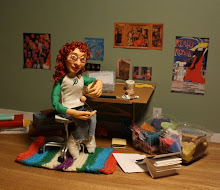
 I liked Rebecca Stead's second novel, the Newbery Award winning When You Reach Me, but First Light, her debut novel, gripped me even more. While Stead's love of Madeleine L'Engle is blatant in When You Reach Me, any L'Engle lover will recognize her influence in First Light. Think Troubling a Star meets aspects of the Wrinkle in Time series, complete with a mitochondria-studying mother and father whose scientific research takes him to strange places.
I liked Rebecca Stead's second novel, the Newbery Award winning When You Reach Me, but First Light, her debut novel, gripped me even more. While Stead's love of Madeleine L'Engle is blatant in When You Reach Me, any L'Engle lover will recognize her influence in First Light. Think Troubling a Star meets aspects of the Wrinkle in Time series, complete with a mitochondria-studying mother and father whose scientific research takes him to strange places.Written in the third person, First Light jumps between three characters, spending the most time with Peter and Thea. Peter is fourteen and lives in NYC with his parents. His mother, who is writing a book about mitochondria, has occasional headaches, which cause her to spend a few days at a time unmoving. When Peter himself starts experiencing these headaches, he keeps them secret, along with the strange visions that accompany them. Peter's father, a professor and glaciologist interested in global warming, takes Peter and his mother to Greenland, where he's situated for six weeks gathering data. After a few weeks, it becomes clear to Peter that his parents are searching for something more than snow statistics.
Interspersed with Peter's life are chapters of Thea's. Thea's world, Gracehope, is strange and other, a place where bowls are made of ice, and people skate from place to place; not to mention that Gracehope exists entirely underground. Thea is raised by her aunt, her mother having died in a vast underground lake, attempting to find a place where Gracehope could expand.
Thea and Peter's stories slowly grow together, and readers will enjoy piecing together their mysteries in an attempt to learn the truths that bind the two characters together.
Honestly, I enjoyed this even more than When You Reach Me. To anyone who has recently enjoyed one of Rebecca Stead's books, you will fall madly in love with L'Engle if you haven't already.
Oh- and thank you to Rebecca Stead. Now that L'Engle is gone, it's nice to see you on the scene.

